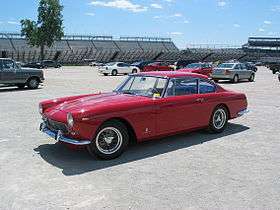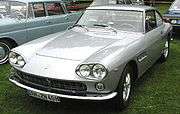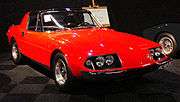Ferrari 330
| Ferrari 330 | |
|---|---|
| Overview | |
| Manufacturer | Ferrari |
| Production | 1963–1968 |
| Body and chassis | |
| Class | Sports car / Grand tourer (S) |
| Layout | FR layout |
| Powertrain | |
| Engine | 4.0 L Colombo V12 |
The Ferrari 330 was a series of V12 powered automobiles produced by Ferrari in 2+2 GT Coupé, two-seat Berlinetta, spyder, and race car versions between 1963 and 1968.
The first, the 2+2 330 America, was a 250 GT/E with a larger 3.3 litre engine; the 330 GTC/GTS shared its chassis with the 275; the 330 GT 2+2 had its own chassis and bodywork; the mid-engined 330P racer was part of the Ferrari P series, produced in four models. Production ended in 1968 with the introduction of the Ferrari 365 series.
All 330 models used an evolution of the 400 Superamerica's 4.0 L Colombo V12 engine. It was substantially changed, with wider bore spacing and an alternator replacing a generator.
330 America
| 330 America | |
|---|---|
 | |
| Overview | |
| Production |
1963 50 produced |
| Designer | Pininfarina |
| Body and chassis | |
| Body style | 2+2 Coupé |
| Related | Ferrari 250 GT/E 2+2 |
| Chronology | |
| Predecessor | Ferrari 250 GT/E 2+2 |
| Successor | Ferrari 330 GT 2+2 |
The 1963 330 America shared the outgoing 250 GTE's chassis but not its engine, being powered by the new 4.0 L Tipo 209 V12, with 300 hp (220 kW) at 6,600 rpm. As for the 250-series, "330" refers to the approximate displacement of each single cylinder.
Socialite Sandra West is buried with her blue 330 America at the Alamo Masonic Cemetery at San Antonio, Texas.
About 50 330 Americas were built before being replaced by the larger 330 GT 2+2.[1]
330 GT 2+2
| 330 GT 2+2 | |
|---|---|
 330 GT 2+2 Series II | |
| Overview | |
| Production |
1964–1967 1,099 produced |
| Designer | Tom Tjaarda at Pininfarina[2] |
| Body and chassis | |
| Body style | 2+2 Coupé |
| Chronology | |
| Predecessor |
Ferrari 250 GT/E 2+2 Ferrari 330 America |
| Successor | Ferrari 365 GT 2+2 |
The provisional 330 America was replaced in January 1964 by the new 330 GT 2+2. It was first shown at the Brussels Show, early that year.[1] It was much more than a re-engined 250, however, with a sharper nose and tail, quad headlights, and a wide grille. The wheelbase was 50 mm (2.0 in) longer, but Koni adjustable shock absorbers improved handling. A dual-circuit Dunlop braking system was used with discs all around, though it separated brakes front to back rather than diagonally as on modern systems. When leaving the factory the 330 GT originally fitted Pirelli Cinturato 205VR15 tyres (CN72).
The 1965 Series II version featured a five-speed gearbox instead of the overdrive four-speed of the prior year. Other changes included the switch back to a dual-light instead of quad-light front clip, alloy wheels, and the addition of optional air conditioning and power steering.[3] Prior to the introduction of the 'Series II' 330 GTs, a series of 125 'interim' cars were produced, with the quad-headlight external configuration of the Series I cars, but with the five-speed transmission and 'suspended' foot pedals of the 'Series II' cars.
625 Series I (including 125 'interim' cars) and 455 Series II 330 GT 2+2 cars had been built when the car was replaced by the 365 GT 2+2 in 1967.[4] Production of the smaller 330 GTC and GTS models overlapped with the GT 2+2 for more than a year.
|
330 GTC/GTS
| 330 GTC, 330 GTS | |
|---|---|
 Ferrari 330 GTS | |
| Overview | |
| Production |
1966–1968 GTC: 598 produced GTS: 100 produced |
| Designer | Pininfarina |
| Body and chassis | |
| Body style |
GTC: 2-seat coupé GTS: 2-seat Spider |
| Chronology | |
| Predecessor |
GTC: Ferrari 250 GT GTS: Ferrari 275 GTS |
| Successor |
GTC: Ferrari 365 GTC GTS: Ferrari 365 GTS |
The 330 GTC and 330 GTS were more like their 275 counterparts than the 330 GT 2+2. They shared the short wheelbase of the 275 as well as its independent rear suspension. These models were more refined than earlier Ferraris, quieter and easier to drive. It has been stated that this "was probably the first Ferrari in which you could actually enjoy a radio".[5]
The GTC berlinetta was introduced at the Geneva Motor Show in March, 1966.[5] It was a two-seater coupé with a Pininfarina-designed body. A 1967 GTC was given one-off bodywork by Zagato at the behest of American importer Luigi Chinetti in 1974. This car was called the "Zagato Convertibile", since it was of a targa-style.
The GTS spider followed at the Paris Motor Show. About 600 coupés and 100 spiders were produced before the 1968 introduction of the 365 GTC and GTS.
|
330 LMB

Four 330 Le Mans Berlinettas were built in 1963. First presented in March 1963 alongside the mid-engined 250 P, they were essentially a development of the 250 GTOs and fitted with the 4-litre 330 engine, here rated at 390 hp (291 kW) at 7,500 rpm.[6] Although the front is visually similar to the 250 GTOs, the main structure came from the 250 Lusso. These four cars are not the same as the "330 GTOs". The wheelbase, at 2,420 mm (95 in),[6] was also 100 mm longer than either the Lusso's or the GTO's. The raised plates on the top of the rear fenders were necessary to clear the rear tires.
The LMB (originally simply the "330 LM") did not see much racing, as Ferrari was moving over to the mid-engined layout for racing. One retired at Sebring 1963, while of three starters at Le Mans that year, two retired and the car of Jack Sears and Mike Salmon came in fifth. After this, the LMB saw no more works entries.[7]
330 P

Four models of mid-engined racing cars used the 330 engine and name as well — the 330 P/P2/P3/P4 range of the mid 1960s. The 330 P4 had 450 hp at 8000 rpm, which combined with its low weight of 792 kg (1746,06 lb) resulted in a top speed of 320 km/h (198.85 mph).[8]
References
- Eaton, Godfrey (1982), the Editors of Consumer Guide, eds., Ferrari: The Sports/Racing and Road Cars, New York, NY: Beekman House, ISBN 0-517-381982
- Eaton, Godfrey (1985), The Complete Ferrari, London: Cadogan Books, pp. 92f., 131–135, 140–150, 163/164, 353f., ISBN 0-947754-10-5
- 1 2 Eaton (1982), p. 114
- ↑ "Cars by Tom Tjaarda". tom-tjaarda.net. Retrieved 2013-06-11.
- ↑ Ahlgrim, Steve (February 2013). "1965 Ferrari 330 GT 2+2 Barn Find". Sports Car Market. 25 (2): 43.
- ↑ "Serial Numbers". 330 Register. Ferrari 330 Register. Retrieved 2013-06-06.
- 1 2 Eaton (1982), p. 116
- 1 2 "Ferrari 330 LM". Ferrari GT - en-EN. Retrieved 2016-01-08.
- ↑ Eaton (1982), p. 93
- ↑ "Ferrari 330 P4". Ferrari GT - en-EN. Retrieved 2016-01-08.
External links
| Wikimedia Commons has media related to Ferrari 330. |
| « previous — Ferrari road car timeline, 1960s–1990s — next » | |||||||||||||||||||||||||||||||||||||||||
|---|---|---|---|---|---|---|---|---|---|---|---|---|---|---|---|---|---|---|---|---|---|---|---|---|---|---|---|---|---|---|---|---|---|---|---|---|---|---|---|---|---|
| Type | 1960s | 1970s | 1980s | 1990s | |||||||||||||||||||||||||||||||||||||
| 0 | 1 | 2 | 3 | 4 | 5 | 6 | 7 | 8 | 9 | 0 | 1 | 2 | 3 | 4 | 5 | 6 | 7 | 8 | 9 | 0 | 1 | 2 | 3 | 4 | 5 | 6 | 7 | 8 | 9 | 0 | 1 | 2 | 3 | 4 | 5 | 6 | 7 | 8 | 9 | ||
| 8 cylinder | Mid-engine berlinetta | 308 | 308 i | 308 QV | 328 | 348 | 360 | ||||||||||||||||||||||||||||||||||
| 208 | 208 Turbo | GTB/GTS Turbo | F355 | ||||||||||||||||||||||||||||||||||||||
| Mid-engine 2+2 | 308 GT4 | Mondial 8 | Mondial QV | Mondial 3.2 | Mondial t | ||||||||||||||||||||||||||||||||||||
| 208 GT4 | |||||||||||||||||||||||||||||||||||||||||
| 12 cylinder | Boxer berlinetta | 365 BB | 512 BB | 512i BB | Testarossa | 512TR | F512M | ||||||||||||||||||||||||||||||||||
| Grand tourer | 250 | 275 | 365 GTB/4 "Daytona" |
550 Maranello | |||||||||||||||||||||||||||||||||||||
| America | 330 | 365 | |||||||||||||||||||||||||||||||||||||||
| 2+2 coupé | 250 GT/E | 330 GT 2+2 | 365 GT 2+2 | 365 GTC/4 |
365 GT4 2+2 | 400 | 400 i | 412 | 456 | 456 M | |||||||||||||||||||||||||||||||
| Supercar | 250 GTO | 250 LM | 288 GTO |
F40 | F50 | ||||||||||||||||||||||||||||||||||||
| Sold under the Dino marque until 1976; see also Dino car timeline | |||||||||||||||||||||||||||||||||||||||||

.jpg)
.jpg)
